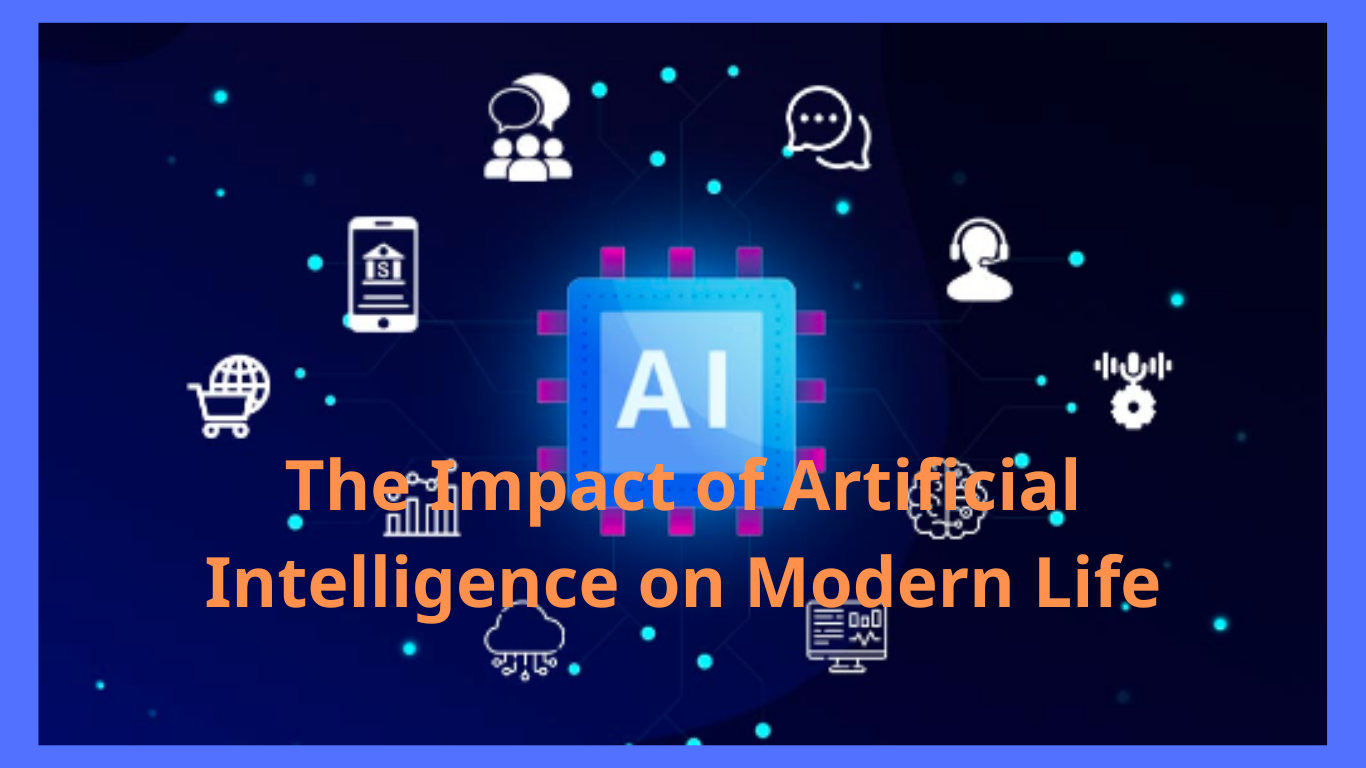The Impact of Artificial Intelligence on Modern Life
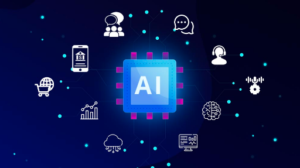
Contents
Introduction:
Artificial Intelligence (AI) has revolutionized modern life in ways we couldn’t have imagined a few decades ago. From personalized recommendations on streaming platforms to autonomous vehicles navigating our streets, AI permeates every aspect of our daily existence. In this article, we delve into the profound implications of AI on contemporary living, exploring its multifaceted role across various domains.
The Role of AI in Healthcare:
AI’s integration into healthcare has significantly enhanced diagnosis, treatment, and patient care. Advanced algorithms analyze medical data with unprecedented accuracy, enabling early detection of diseases and personalized treatment plans. Moreover, AI-powered robotics assist surgeons in complex procedures, minimizing human error and improving surgical outcomes. As the healthcare industry embraces AI-driven innovations, we witness a paradigm shift towards preventive healthcare and precision medicine.
In the healthcare sector, Artificial Intelligence (AI) is having a broad and positive impact, bringing many benefits to patients and healthcare providers. Here are some important impacts of AI in healthcare:
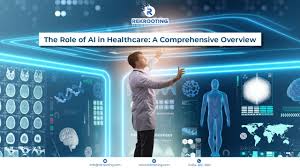
Disease diagnosis and prediction: AI technology can analyze medical data from medical records, medical images and genetic data to assist in diagnosing diseases and predicting health risks. Strong.
Personalized healthcare: AI technology can create personalized healthcare applications and services based on each person’s medical data, helping to improve disease management and promote healthy lifestyles. strong.
Enhance public health management: AI can be used to analyze data from different sources such as social networks, contact tracing data, and public health data to predict and control epidemics .
Support in treatment: AI technology can assist therapists by analyzing medical data to find the most effective treatments and customize therapy for each specific patient.
Optimize medical processes: AI can be used to optimize medical processes, from appointment scheduling to patient data management, helping to reduce waiting times and increase patient productivity. medical service provider.
Medical research and pharmaceutical development: AI can analyze large and complex medical data to find connections between health factors and develop new drugs.
However, implementing AI technology in healthcare also poses a number of challenges, including issues of privacy, ethics and data reliability, as well as accessibility for everyone. for these services.
AI in Finance and Economics:
In the realm of finance, AI algorithms sift through vast datasets to predict market trends and optimize investment strategies. High-frequency trading platforms leverage AI to execute transactions with lightning speed, capitalizing on minute fluctuations in stock prices. Furthermore, AI-powered chatbots streamline customer service in banking and insurance sectors, enhancing user experience and reducing operational costs. The fusion of AI and finance redefines traditional business models, fostering greater efficiency and resilience in volatile markets.
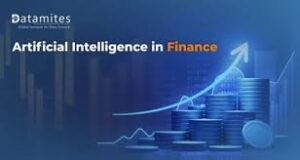
Artificial intelligence (AI) has a profound impact on finance and economics. Here are some key influences:
Enhance performance and optimize processes: AI is used to automate many processes in financial institutions, from risk management to financial transactions. This helps increase efficiency, reduce errors and save costs.
Data analysis and prediction: AI technology is capable of analyzing large and complex financial data, from market data to customer data, to make important predictions and trends. This helps investors and businesses make smarter decisions.
Automated financial transactions: AI is used in automated financial transactions, including high-speed financial transactions and algorithmic financial transactions. This can create benefits in enhancing market liquidity and reducing financial risk.
Personalized financial services: AI technology helps create personalized financial services based on the behavior and needs of each specific customer. This can increase customer satisfaction and create new business opportunities.
Fraud detection and financial security: AI is used to detect financial fraud and protect financial systems from cyber threats. This enhances the safety and reliability of the financial system.
Impact on the labor market: AI could lead to changes in working practices and labor structures in the financial industry, with some jobs becoming automated and some new skills becoming necessary .
However, implementing AI also poses a number of challenges, including issues of privacy, ethics and data reliability, as well as the impact on job losses and labor structures.
AI and Education:
Education undergoes a transformational journey with the integration of AI technologies. Adaptive learning platforms tailor educational content to individual student needs, fostering personalized learning experiences. AI algorithms analyze student performance data to identify areas of improvement and suggest tailored interventions. Additionally, virtual tutors equipped with natural language processing capabilities offer real-time assistance, supplementing traditional classroom instruction. By harnessing AI’s potential, education becomes more accessible, engaging, and effective, empowering learners worldwide.
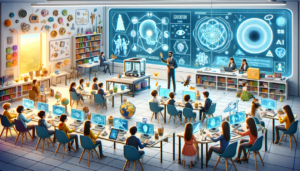
Revolutionizing education with Artificial Intelligence (AI) is creating many new opportunities and changing the way we teach, learn and manage education. Here are some of the ways AI is affecting the education sector:
Personalized learning: AI can analyze data about each student’s learning behavior to create personalized learning plans tailored to each specific student’s learning needs. This helps increase academic performance and minimize dropouts.
Educational content development: AI can be used to create personalized educational content based on each student’s learning needs and specific learning conditions. This can enhance the appeal and effectiveness of learning.
Teacher training: AI can be used to provide training to teachers, helping them develop their teaching and classroom management skills through student data analysis and instant feedback.
Support teachers in assessment and feedback: AI can be used to automate student assessment and provide feedback to teachers, helping them better understand each student’s academic progress and provide appropriate support.
Access to education: AI can be used to create online education platforms and mobile applications, helping to expand access to education for everyone, including those in remote areas remote or have limited resources.
Educational research and development: AI can analyze data about learning processes and the effectiveness of teaching methods to help improve education systems and develop new teaching methods.
However, applying AI in education also poses a number of challenges, including issues of privacy, fairness and reliability of data, as well as the need for human support in the process. educational program.
AI and Environmental Sustainability:
Amid growing environmental concerns, AI emerges as a potent tool for addressing sustainability challenges. Machine learning algorithms optimize energy consumption, enabling smart grids to efficiently distribute electricity and reduce carbon emissions. Furthermore, AI-powered drones monitor ecosystems, detecting deforestation, and wildlife poaching in real-time. Precision agriculture techniques leverage AI to enhance crop yields while minimizing environmental impact through targeted resource allocation. By harnessing AI’s analytical prowess, we navigate towards a greener and more sustainable future.

Artificial intelligence (AI) has an important role in contributing to environmental sustainability through a variety of ways:
Natural Resource Management: AI can be used to analyze data about the use and management of natural resources such as water, land, and forests. In this way, it can help predict environment-related problems and propose more effective solutions for resource protection.
Environmental monitoring: AI can help monitor the environment through analyzing satellite images, sensor data and other environmental data. This can help detect problems such as air pollution, biodiversity loss and climate change early.
Risk management and resilience: AI can be used to predict and manage environmental risks, including events such as hurricanes, droughts and floods. It can also help locate high-risk areas and develop post-disaster recovery plans.
Energy system optimization: AI can be used to optimize energy use and manage energy systems by predicting demand and optimizing operations. This can help reduce greenhouse gas emissions and increase energy savings.
Protecting biodiversity: AI can be used to monitor and protect biodiversity by analyzing data on species populations, habitat loss, and other issues. This helps identify areas that need protection and develop effective conservation measures.
Support in policy decisions: AI can provide analytical tools and simulation models to support environmental policy decisions, including assessing the environmental impact of policies and forecasting their results.
Conclusion:
In conclusion, the pervasive influence of AI reshapes the fabric of modern society across diverse sectors. From healthcare to finance, education, and environmental sustainability, AI’s transformative potential knows no bounds. As we navigate the complexities of an AI-driven world, it’s imperative to harness its capabilities ethically and responsibly, ensuring equitable access and safeguarding against potential pitfalls. Embracing AI’s evolution, we embark on a journey towards a more innovative, inclusive, and sustainable future.
